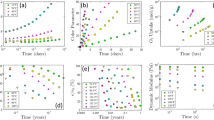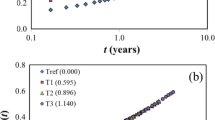Abstract
Time-temperature superposition (TTS), which for decades has been a powerful method for long-term prediction from accelerated aging data, involves rigid-shifting isotherms in logarithmic time to produce a single master prediction curve. For simple thermo-rheological properties that accurately follow the TTS principle, the shifts can be easily determined, even manually by the eye. However, for many properties of interest, where the principle is obeyed only approximately, or the data is noisy, it is imperative to develop objective shifting techniques along with reliable uncertainty bounds. This work analyzes in detail the method of arclength-minimization as an unsupervised algorithm to determining optimum shifts and demonstrates that the method is nearly unbiased for all practical datasets with a variety of noise distributions. Moreover, if averaged over with-replacement (bootstrap) resamples, the predicted shifts follow a normal distribution, a fact that can be used to construct confidence interval for the master curve through a second-order bootstrap procedure.







Similar content being viewed by others
References
Alwis KGNC, Burgoyne CJ (2006) Time-temperature superposition to determine the stress-rupture of aramid Fibres. Appl Compos Mater 13:249–264
Bae J-E, Cho KS, Seo KH, Kang D-G (2011) Application of geometric algorithm of time-temperature superposition to linear viscoelasticity of rubber compounds. Korea-Aust Rheol J 23:81–87
Barbero EJ, Ford KJ (2004) Equivalent time temperature model for physical aging and temperature effects on polymer creep and relaxation, ASME J. Eng Mater Technol 126:413
Buttlar WG, Roque R, Reid B (1998) Automated procedure for generation of creep compliance master curve for asphalt mixtures. J Transp Res Board 1630:28–36
Cady HH (1972) The PETN-DiPEHN-TriPEON system, LA-4486-MS, Los Alamos, NM, USA
Cho KS (2009) Geometric interpretation of time-temperature superposition. Korea-Aust Rheol J 21:13
Cho, K. S. (2016) Viscoelasticity of Polymers, Ch. 8, Springer, Dordrecht, Netherlands
Christensen RM (1971) Theory of viscoelasticity – an introduction. Academic Press, New York
Cleveland WS, Devlin SJ (1988) Locally weighted regression: an approach to regression analysis by local fitting. J Am Stat Assoc 83:569–610
Coons JE, McKay MD, Hamada MS (2006) A Bayesian analysis of the compression set and stress-strain behavior in a thermally aged silicone foam. Polym Degrad Stab 91:1824–1836
Dinegar RH (1987) The effect of heat on Pentaerythritol Tetranitrate (PETN), international conference of the Groupe de travail de Pyrotechnie Spatiale, Juan les pins, France, June 8–12, P. 105
Efron B, Tibshirani R (1986) Bootstrap methods for standard errors, confidence intervals, and other measures of statistical accuracy. Stat Sci 1:54–75
Ferry JD (1980) Viscoelastic properties of polymers. John Wiley and Sons, New York
Foltz MF (2009) Aging of Pentaerythritol Tetranitrate (PETN), LLNL-TR-415057. Lawrence Livermore National Laboratory, CA, USA
Gergesova M, Zupancic B, Supranov I, Emri I (2011) The closed form t-T-P shifting (CFS) algorithm. J Rheol 55(1):1–16
Hermida EB, Povolo F (1994) Analytical-numerical procedure to determine if a set of experimental cuves can be superimposed to form a master curve. Polym J (Tokyo, Jpn) 26:981–992
Honerkamp J, Weese J (1993) A note on estimating mastercurves. Rheol Acta 32:57–64
ISO 18437-6 (2017) Mechanical vibration and shock -- characterization of the dynamic mechanical properties of visco-elastic materials -- part 6: time-temperature superposition. BSI Standards Ltd
Knauss WG (2008) The sensitivity of the time-temperature shift process to thermal variations — a note. Mech Time-Depend Mater 12:179–188
Laidler KJ (1987) Chemical kinetics. Harper and Row, New York
Lau KH, Hildenbrand DL, Crouch-Baker S, Sanjurjo A (2004) Sublimation pressure and vapor molecular weight of Pentaerythritol Tetranitrate. J Chem Eng Data 49:544–546
Lewicki JP, Maxwell RS, Mayer BP, Maiti A, and Harley SJ (2014) The Development and Application of NMR Methodologies for the Study of Degradation in Complex Silicones, Ch 11 (P 153–176), Concise Encyclopedia of High Performance Silicones, Eds. A. Tiwari and M. D. Soucek, Wiley, Scrivener Publishing
Li Y, Aberton BC, Kröger M, Liu WK (2013) Challenges in multiscale modeling of polymer dynamics. Polymer 5:751–832
Maiti A, Small W, Lewicki J, Weisgraber T et al (2016) 3D printed cellular solid outperforms traditional stochastic foam in long-term mechanical response. Scientific Reports (Nature) 6:24871
Maiti A (2016) A geometry-based approach to determining time-temperature superposition shifts in aging experiments. Rheol Acta 55:83–90
Maiti A, Olson TY, Han TY, Gee RH (2017) Long-term coarsening and function-time evolution of an initiator powder. Propell Explos Pyrot 42:1352–1357
Mayer R, Köhler J, Homburg A (eds) (2007) Explosives, 6th edn. Wiley-VCH, Weinheim
Messinger RJ, Marks TJ, Gleiman SS, Milstein F, Chmelka BF (2015) Molecular origins of macroscopic mechanical properties of elastomeric Organosiloxane foams. Macromolecules 48:4835–4849
Morrell PR, Patel M, Pitts S (2012) X-ray CT microtomography and mechanical response of foamed polysiloxane elastomers. Polym Test 31:102–109
Naya S, Meneses A, Tarrio-Saavedra J, Artiaga R, Lopez-Beceiro J, Gracia-Fernandez C (2013) New method for estimating shift factors in time–temperature superposition models. J Therm Anal Calorim 113:453–460
Neag CM, Bruce Prime R (1991) Application of time/temperature superposition techniques to powder coating cure. J Coatings Technol 63:37
Patel M, Skinner AR (2001) Thermal ageing studies on room-temperature vulcanised polysiloxane rubbers. Polym Degrad Stab 73:399–402
Patel M, Chinn SC, Maxwell RS, Wilson TS, Birdsell SA (2010) Compression set in gas-blown condensation-cured polysiloxane elastomers. Polym Degrad Stab 95:2499–2507
Patterson BM, Henderson K, Smith Z (2012) Measure of morphological and performance properties in polymeric silicone foams by X-ray tomography. J Mater Sci 48:1986–1996
Rault J (2000) Origin of the Vogel–Fulcher–Tammann law in glass-forming materials: the α–β bifurcation. J Non-Crystalline Solids 271:177–217
Williams ML (1964) Structural analysis of viscoelastic materials. AIAA J 2:785–808
Williams ML, Landel RF, Ferry JD (1955) The temperature dependence of relaxation mechanisms in amorphous polymers and other glass-forming liquids. J Amer Chem Soc 77:3701–3707
Zhao J, Knauss WG, Ravichandran G (2007) Applicability of the time–temperature superposition principle in modeling dynamic response of a polyuria. Mech Time-Depend Mater 11:289–308
Acknowledgments
The author would like to thank colleagues at LLNL for sharing experimental data and for useful discussions, particularly Ward Small, Jim Lewicki, Sarah Chinn, Tom Wilson, Andrew Saab, Chris Grant, Richard Gee, and Bob Maxwell. This work was performed under the auspices of the U.S. Department of Energy by Lawrence Livermore National Laboratory under Contract DE-AC52-07NA27344.
Author information
Authors and Affiliations
Corresponding author
Additional information
Publisher’s note
Springer Nature remains neutral with regard to jurisdictional claims in published maps and institutional affiliations.
Rights and permissions
About this article
Cite this article
Maiti, A. Second-order statistical bootstrap for the uncertainty quantification of time-temperature-superposition analysis. Rheol Acta 58, 261–271 (2019). https://doi.org/10.1007/s00397-019-01138-y
Received:
Revised:
Accepted:
Published:
Issue Date:
DOI: https://doi.org/10.1007/s00397-019-01138-y




